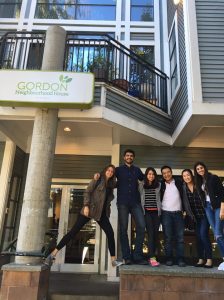
Meet Our Group! (L-R: Brook, Farivar, Misa, Kaelan, Nancy, Kim)
“Give a man a fish and you feed him for a day; teach a man to fish and you feed him for a lifetime,” is a well-know quote put forth by Jewish philosopher Maimonides (n.d.) and how true it is. Why? Keep reading and we will show you why this quote is relevant to our project.
Welcome to the our blog! We are a group of six UBC Land and Food Systems (LFS) 350 students who will be working with a fantastic organization called Gordon Neighbourhood House with their Community Food Hub and we would like to share our experiences with you.
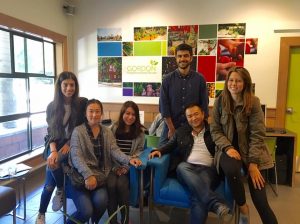
Inside the GNH (L-R: Kim, Nancy, Misa, Farivar, Kaelan, Brook)
As a group we are interested in making a positive impact within the community while simultaneously learning about food literacy and food justice. Additionally, we are very keen on emphasizing healthy eating and nutritional knowledge. We chose to work with Gordon Neighbourhood House on the Community Food Hub project because we would like to learn about food preservation methods, provide support for the connection between local farms and community, learn more about, and get involved with Gordon Neighborhood House, and be able to better our food literacy skills while helping others better their’s as well.
What we hope to gain from our experiences in taking LFS 350 is a greater understanding of how we can help move the food system in a sustainable direction. Furthermore, we would like to get to know the community better in terms of what types of problems and issues they’re facing while helping them get to the root of the problem and taking steps in the right direction towards solving it.
Each person in our group has specific interests and strengths that compliment our overall group interests, goals, and reasons for selecting this particular project. We will each tell you what they are!





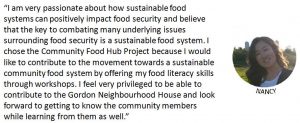
Now that you know a little bit about who we are and where our interests lie, let’s talk a little bit about Gordon Neighbourhood House and the project we will be working on.
It is always such a tremendous learning experience when we first meet our community partners and learn about their story. For us, we have the opportunity to work with one of the earliest established neighbourhood houses in Vancouver – The Gordon Neighbourhood House. It’s rich history spans almost 75 years!
Paul Taylor, the director of Gordon Neighbourhood House eloquently described to us the difference between a community centre and a neighbourhood house as “where a community center works FOR the community, a neighborhood house works WITH the community.” This is apparent in their food security initiatives.
The Gordon neighborhood House was approached by the Greater Vancouver Food Bank to take on one of the Food Bank locations when one of the previously existing locations in the West End was shut down. They accepted, with the agreement that some changes would be made. That is how the Community Food Hub was born.
The Gordon Neighborhood House’s goal is to take action further down the food security continuum. Where the Food Bank focuses on emergency and charitable services, which falls under Stage 1-Short Term Relief, Gordon Neighborhood House strives to create initiatives that focus more on Stage 2-Capacity building. To further their goal, they have partnered up with some advocacy groups, such as “Raise the Rates” which is working to address the underlying cause of food insecurity for many: poverty. This strategy encompasses Stage 3-Redesign which is focused on policy and system changes.
The Gordon Neighborhood House’s goal is to take action further down the food security continuum, because as Paul Taylor explained, success is not being at one stage of the continuum, rather it is movement along it. An outline of the type of continuum Paul Taylor discussed is found on the Food Security Alberta website (http://www.foodsecurityalberta.org/food-security-continuum), which is what we will use. The Food Bank focuses on emergency and charitable services, which falls under Stage 1-Short Term Relief, while Gordon Neighborhood House strives to create initiatives that shift the focus more to Stage 2-Capacity Building. This is the stage at which many of their community building initiatives are working, such as the community gardens, as well as some of the changed aspects of the Community Food Hub. GNH is also attempting to work at the root causes of food insecurity, which falls under Stage 3-Redesign. This is focused on the policies and systems that are at the root of the inequalities in the food system, and is where food justice comes into play. For example, GNH is starting to work with “Raise the Rates”, a coalition intended to raise welfare rates (https://raisetherates.org/) and work to address the underlying cause of food insecurity for many: poverty. These kind of social advocacy and policy change initiatives are working near the end of the food security continuum, which is necessary for food justice to be achieved.
Gordon Neighbourhood House made changes to the classic Food Bank design in order to focus more on capacity building within the community which fosters a sense of autonomy, dignity, community, and respect within the individuals they serve. This is achieved by their innovative way of transforming the process to more like a shopping experience where individuals can walk through and choose the food items that want, giving individuals more time to come pick up their food, and minimizing wait time. The Community Food Hub lasts four hours, where the Food Bank gave only one! This has a great impact on eliminating the line-ups found at most Food Banks, which many people find degrading.
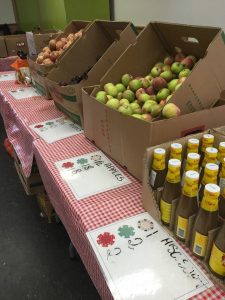
An innovative method towards food autonomy
Their experience does not end there! After grocery pickup, they can go upstairs to socialize, have lunch and snacks, shop at the bargain-priced Produce Market, and watch the chef demonstrate cooking with freshly harvested vegetables of week. All of these changes made to the classic Food Bank model are how GNH is moving along the food security continuum to capacity building within the community. An astounding 250-350 households frequent the Food Hub within the span of 4 hours!
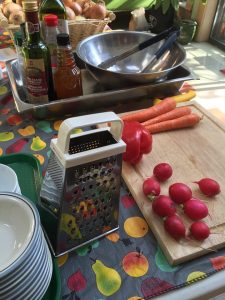
Cooking demonstration by GNH’s in-house chef
After polling individuals who utilize the Community Food Hub Program, it was found that there were a number of services that individuals were particularly seeking. That’s where our group comes in. One of the things that individuals wanted to see on Food Hub Fridays was the introduction of workshops that can teach them tangible food literacy skills. More importantly, it is how to utilize food items that they readily have access to. Therefore, over the course of the upcoming months, our task is to design and implement various workshops that would serve this purpose. In addition, in order to really get sense of how the Community Food Hub Program works, each of us will volunteer in the Food Hub helping out in areas such as the in-house Produce Market.
One of the first impressions that we got after meeting with both the Executive Director, Paul Taylor and the Farmer/Community Programmer, Susanna Millar, was that in order to conduct this project successfully and obtain the full experience, we are expected to be patient and listen to the fellow community members. Many of the individuals who attend the Gordon House programs are food insecure and a proper income is an issue for them, therefore Susanna made it clear that we are not only here to improve food literacy skills, but also to provide emotional comfort for the individuals who visit the neighborhood house. As Ernesto Sirolli (2012) mentioned in his TED talk, “instead of arriving in a community to tell people what to do, why don’t we for once listen to them,” by doing so, we allow the individuals to feel comfortable in sharing their struggles, maximizing the potential for our ability to help and make an effective change through relationship development.
Presently, building a strong relationship with the community members appears to be the main focus as this creates the foundation necessary to make a significant impact regarding community development — a factor that is deemed highly important in the Asset-Based Community Development approach as it emphasizes engagement as well as meaningful community improvements through recognizing and utilizing the unique abilities and skills already present in a community. Last but not least, Ernesto Sirolli also emphasizes that it takes a network of people to build a great company and this reflects the Gordon Neighbourhood House where we have a network of people from different backgrounds all with a common goal: to make a positive impact on their community.
After learning more about our project and Gordon Neighbourhood House’s mission, we can now revisit Maimondes’ famous quote. It is apparent that although food emergency services may provide much needed food to those who are in need, it is with additional services such as workshops that compliment the Food Hub program that will empower individuals with the food literacy skills that will carry them forward into a more food secure future.
Tune in next time when we disclose our top secret project proposal!
References
Food Security Continuum. (n.d.). Retrieved October 02, 2016, from http://www.foodsecurityalberta.org/food-security-continuum
Maimonides. (n.d.). BrainyQuote.com. Retrieved September 30, 2016, from BrainyQuote.com Web site: https://www.brainyquote.com/quotes/quotes/m/maimonides326751.html
[TED]. (2012, November 26). Ernesto Sirolli: Want to help someone? Shut up and listen![Video File]. Retrieved from https://www.youtube.com/watch?v=chXsLtHqfdM
